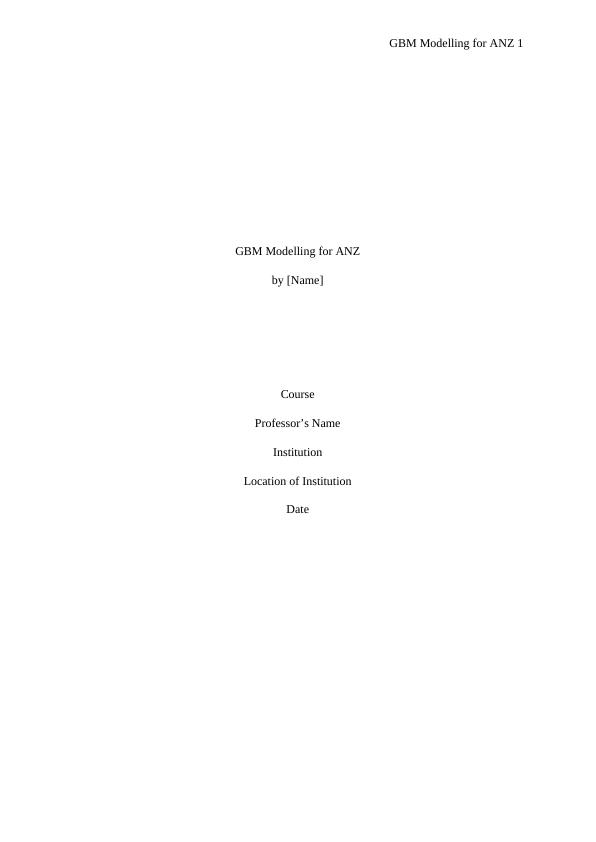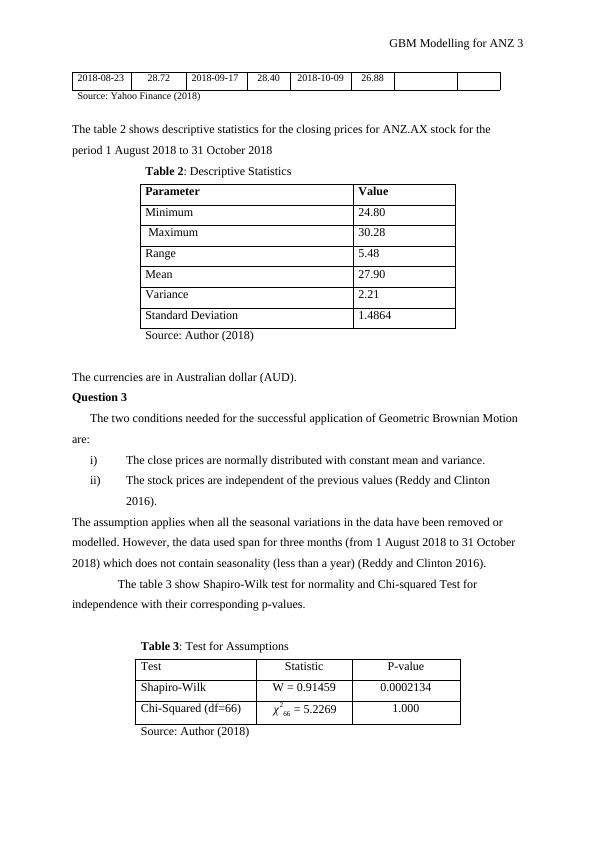GBM Modelling for ANZ .
Added on 2023-05-28
10 Pages2119 Words442 Views
GBM Modelling for ANZ 1
GBM Modelling for ANZ
by [Name]
Course
Professor’s Name
Institution
Location of Institution
Date
GBM Modelling for ANZ
by [Name]
Course
Professor’s Name
Institution
Location of Institution
Date

GBM Modelling for ANZ 2
GBM Modelling for ANZ
Question 1
The quantity μt – in the percentage drift and σ t – is the percentage volatility. These
parameters are considered constant when solving the differential equation to obtain the
Geometric Brownian Motion which is the solution for the differential. The parameters in time
series analysis of stock returns represents the continuous compounded expected return on the
stock (μt) and stock volatility (σ t) (Yang and Aldous 2015).
The assumptions of Geometric Brownian Motion (GBM) model include stock return
data is assumed to follow a normal distribution with constant mean and variance. Second the
observation at time t is independent of the observations at time t-1 or t + 1 (Yang and Aldous
2015). Also, the data is assumed to be continuous which is not the case with stock data.
Question 2
The company chosen for this study is the Australian and New Zealand Banking Group
(ANZ.AX). Using the r-code presented in the appendix the closing share price for ANZ.AX
was obtained for the period 1 august 2018 to 31 October 2018 from Yahoo Finance. The table
1 shows the stock prices.
Table 1: ANZ.AX Daily Closing Stock Price (1/08/2018 to 31/10/2018)
Date
Closing
Price Date
Closing
Price Date
Closing
Price Date
Closing
Price
2018-08-01 29.07 2018-08-24 28.50 2018-09-18 28.39 2018-10-10 26.01
2018-08-02 28.91 2018-08-27 28.52 2018-09-19 28.66 2018-10-11 25.91
2018-08-03 28.64 2018-08-28 28.78 2018-09-20 28.42 2018-10-14 25.43
2018-08-06 28.92 2018-08-29 29.43 2018-09-21 28.46 2018-10-15 25.55
2018-08-07 29.09 2018-08-30 29.39 2018-09-24 28.58 2018-10-16 25.81
2018-08-08 28.82 2018-08-31 29.50 2018-09-25 28.22 2018-10-17 25.88
2018-08-09 29.17 2018-09-03 29.21 2018-09-26 27.96 2018-10-18 26.04
2018-08-10 29.31 2018-09-04 28.80 2018-09-27 27.79 2018-10-21 25.79
2018-08-13 29.17 2018-09-05 28.59 2018-09-28 28.18 2018-10-22 25.29
2018-08-14 29.64 2018-09-06 28.53 2018-10-01 27.73 2018-10-23 25.45
2018-08-15 30.15 2018-09-07 28.40 2018-10-02 27.49 2018-10-24 24.80
2018-08-16 30.06 2018-09-10 28.26 2018-10-03 27.44 2018-10-25 24.91
2018-08-17 30.28 2018-09-11 28.58 2018-10-04 27.61 2018-10-28 25.20
2018-08-20 30.05 2018-09-12 28.37 2018-10-05 27.72 2018-10-29 25.66
2018-08-21 29.51 2018-09-13 28.06 2018-10-07 26.99 2018-10-30 25.93
2018-08-22 29.22 2018-09-14 28.15 2018-10-08 26.83 2018-10-31 25.85
GBM Modelling for ANZ
Question 1
The quantity μt – in the percentage drift and σ t – is the percentage volatility. These
parameters are considered constant when solving the differential equation to obtain the
Geometric Brownian Motion which is the solution for the differential. The parameters in time
series analysis of stock returns represents the continuous compounded expected return on the
stock (μt) and stock volatility (σ t) (Yang and Aldous 2015).
The assumptions of Geometric Brownian Motion (GBM) model include stock return
data is assumed to follow a normal distribution with constant mean and variance. Second the
observation at time t is independent of the observations at time t-1 or t + 1 (Yang and Aldous
2015). Also, the data is assumed to be continuous which is not the case with stock data.
Question 2
The company chosen for this study is the Australian and New Zealand Banking Group
(ANZ.AX). Using the r-code presented in the appendix the closing share price for ANZ.AX
was obtained for the period 1 august 2018 to 31 October 2018 from Yahoo Finance. The table
1 shows the stock prices.
Table 1: ANZ.AX Daily Closing Stock Price (1/08/2018 to 31/10/2018)
Date
Closing
Price Date
Closing
Price Date
Closing
Price Date
Closing
Price
2018-08-01 29.07 2018-08-24 28.50 2018-09-18 28.39 2018-10-10 26.01
2018-08-02 28.91 2018-08-27 28.52 2018-09-19 28.66 2018-10-11 25.91
2018-08-03 28.64 2018-08-28 28.78 2018-09-20 28.42 2018-10-14 25.43
2018-08-06 28.92 2018-08-29 29.43 2018-09-21 28.46 2018-10-15 25.55
2018-08-07 29.09 2018-08-30 29.39 2018-09-24 28.58 2018-10-16 25.81
2018-08-08 28.82 2018-08-31 29.50 2018-09-25 28.22 2018-10-17 25.88
2018-08-09 29.17 2018-09-03 29.21 2018-09-26 27.96 2018-10-18 26.04
2018-08-10 29.31 2018-09-04 28.80 2018-09-27 27.79 2018-10-21 25.79
2018-08-13 29.17 2018-09-05 28.59 2018-09-28 28.18 2018-10-22 25.29
2018-08-14 29.64 2018-09-06 28.53 2018-10-01 27.73 2018-10-23 25.45
2018-08-15 30.15 2018-09-07 28.40 2018-10-02 27.49 2018-10-24 24.80
2018-08-16 30.06 2018-09-10 28.26 2018-10-03 27.44 2018-10-25 24.91
2018-08-17 30.28 2018-09-11 28.58 2018-10-04 27.61 2018-10-28 25.20
2018-08-20 30.05 2018-09-12 28.37 2018-10-05 27.72 2018-10-29 25.66
2018-08-21 29.51 2018-09-13 28.06 2018-10-07 26.99 2018-10-30 25.93
2018-08-22 29.22 2018-09-14 28.15 2018-10-08 26.83 2018-10-31 25.85

GBM Modelling for ANZ 3
2018-08-23 28.72 2018-09-17 28.40 2018-10-09 26.88
Source: Yahoo Finance (2018)
The table 2 shows descriptive statistics for the closing prices for ANZ.AX stock for the
period 1 August 2018 to 31 October 2018
Table 2: Descriptive Statistics
Parameter Value
Minimum 24.80
Maximum 30.28
Range 5.48
Mean 27.90
Variance 2.21
Standard Deviation 1.4864
Source: Author (2018)
The currencies are in Australian dollar (AUD).
Question 3
The two conditions needed for the successful application of Geometric Brownian Motion
are:
i) The close prices are normally distributed with constant mean and variance.
ii) The stock prices are independent of the previous values (Reddy and Clinton
2016).
The assumption applies when all the seasonal variations in the data have been removed or
modelled. However, the data used span for three months (from 1 August 2018 to 31 October
2018) which does not contain seasonality (less than a year) (Reddy and Clinton 2016).
The table 3 show Shapiro-Wilk test for normality and Chi-squared Test for
independence with their corresponding p-values.
Table 3: Test for Assumptions
Test Statistic P-value
Shapiro-Wilk W = 0.91459 0.0002134
Chi-Squared (df=66) χ2
66 = 5.2269 1.000
Source: Author (2018)
2018-08-23 28.72 2018-09-17 28.40 2018-10-09 26.88
Source: Yahoo Finance (2018)
The table 2 shows descriptive statistics for the closing prices for ANZ.AX stock for the
period 1 August 2018 to 31 October 2018
Table 2: Descriptive Statistics
Parameter Value
Minimum 24.80
Maximum 30.28
Range 5.48
Mean 27.90
Variance 2.21
Standard Deviation 1.4864
Source: Author (2018)
The currencies are in Australian dollar (AUD).
Question 3
The two conditions needed for the successful application of Geometric Brownian Motion
are:
i) The close prices are normally distributed with constant mean and variance.
ii) The stock prices are independent of the previous values (Reddy and Clinton
2016).
The assumption applies when all the seasonal variations in the data have been removed or
modelled. However, the data used span for three months (from 1 August 2018 to 31 October
2018) which does not contain seasonality (less than a year) (Reddy and Clinton 2016).
The table 3 show Shapiro-Wilk test for normality and Chi-squared Test for
independence with their corresponding p-values.
Table 3: Test for Assumptions
Test Statistic P-value
Shapiro-Wilk W = 0.91459 0.0002134
Chi-Squared (df=66) χ2
66 = 5.2269 1.000
Source: Author (2018)

End of preview
Want to access all the pages? Upload your documents or become a member.
Related Documents
Stochastic Processes and Geometric Brownian Motion in Business Analyticslg...
|10
|612
|213
